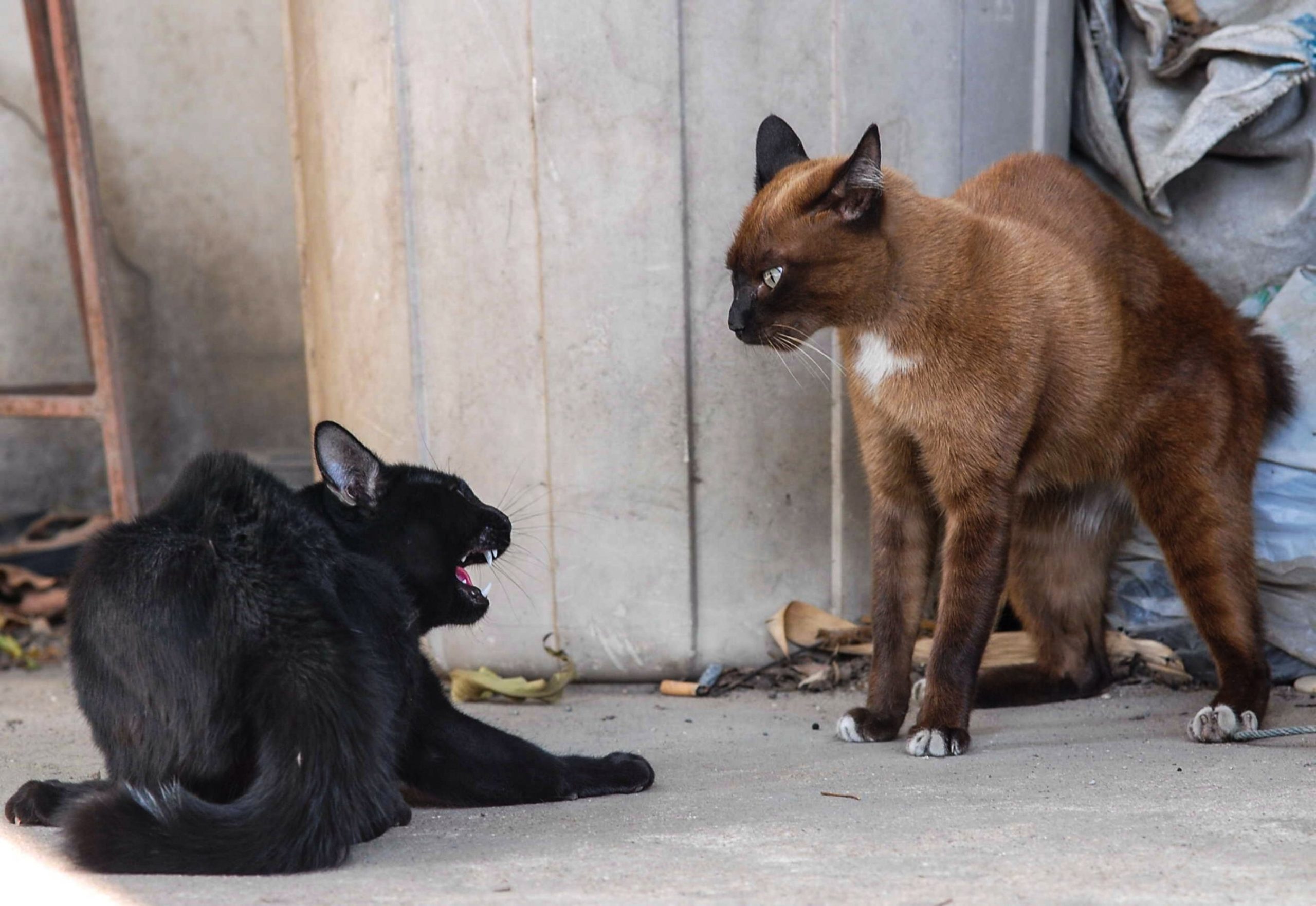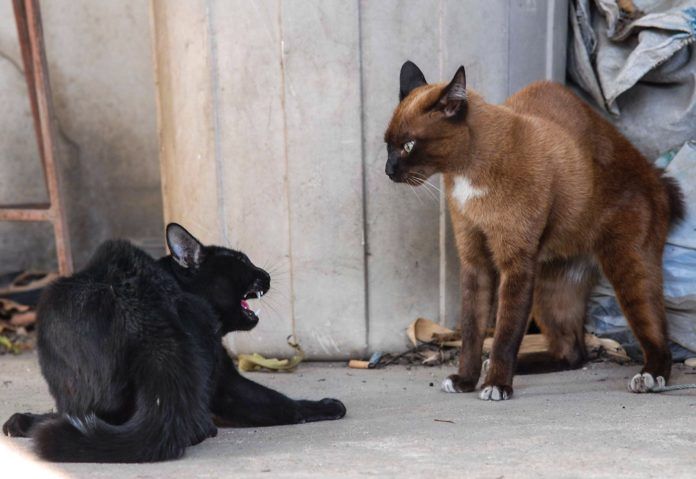Dreamstime.com

A certain amount of conflict and discord is natural in any group living situation. Owners of even the most mellow and congenial cat families know just how quickly conflict can erupt as group members experience the normal ups and downs of life.
Wise owners understand how powerfully even seemingly insignificant changes can affect their cats and disrupt the group’s harmony. They also know how important it is to address the effects of changes positively and immediately, before the situation spins out of control.
Some of the trickiest situations to manage are those when a new family member enters the picture, and when a family member leaves the group. Loss of a human or feline family member — especially a sudden loss — can trigger a cascade of alterations in the group’s structure, upset existing relationships, or even bring to light previously hidden conflicts.
Be prepared for anything
Life is full of surprises, and even the most prescient owner cannot anticipate how a loss or change in the group’s composition will affect his cats and their relationships. With cats, though, it’s always best to be prepared for just about anything: A minor change might cause a major upset, while something human family members see as monumental hurricane might pass through the cat group like a spring breeze.
So it is with introductions. Many introductions — whether of kittens or adult cats — simply go off without a hitch. But difficult introductions, more than any other household change, are what can, too often, bring the cat owner’s most dreaded word — rehoming — into the conversation.
Why does introducing a new cat to a group so often cause such consternation? To a cat, an unfamiliar cat is not a potential friend but a possible threat, in a way that a member of any other species is not. Cats see other cats as direct competitors for the resources they prize the most, such as food, space (territory), social status and attention from favorite humans.
Wise cat owners know how to manage feline introductions to maximize their chances of success. “The ‘yellow’ brick road’ of cat introductions, if carried out religiously, should work most of the time,” says Nicholas Dodman, BVMS, Professor Emeritus at the Tufts Cummings School of Veterinary Medicine.
The best laid plans
But sometimes, even when an owner does everything right, some or all of the cats refuse to go along with the program. “Cats, like people, have different personalities,” says Dr. Dodman. Sometimes it’s the new cat who just refuses to fit in and get along; other times one or more of the resident cats make it abundantly clear that they have no intention of accepting the newcomer as a family member — ever.
“Maybe the cats are incompatible, personality wise. No matter how slowly you go, you still see ears flat back, dilated pupils, hissing, and charging — all the hallmarks of angry cats.”
The domino effect
Weeks and months go by and the fur continues to fly. If you continue to press the point, the situation can deteriorate badly: Previously mellow cats are snarling. Friendly cats are now hiding under the bed. Former friends refuse to cuddle. And someone is missing the litter box more often than not. If the situation has deteriorated to that extent, it’s time to back up and reassess before the group’s harmony is totally destroyed.
No matter how much you want the introduction to work, at some point, it may not be worth putting all your cats under that much continuing stress. That’s when thoughts of rehoming start to assert themselves for some people. Here’s some help in making this difficult decision.
Deciding to Rehome
If all else has truly failed, and you’re unable or unwilling to compartmentalize your home and/or break up your cat group, you may be forced to conclude that finding a suitable new home for the cat is the kindest and most sensible path forward.
If you obtained the newcomer from a breeder, that breeder should be the first person you turn to. Many breeder contracts require that the breeder be notified if you can’t keep the cat for any reason, and that they be given the opportunity to take the cat back.
If you adopted the newcomer from a shelter, you might choose to ask the shelter if they’d be willing to take the cat back. Obviously, a lot depends on the particular shelter, their management practices and philosophies, and how you feel about the shelter. But if you’re comfortable with the shelter, and feel that the cat has a good chance of finding a more suitable home through them, this can be a comfortable option.
One caution, though: Unless you’re quite sure that the newcomer’s own particular quirks were the cause of his failure to be accepted by your cats, resist the urge to take another cat home to “try again.” It might be better to wait awhile, and think more deeply about whether you and your cats are ready for any new addition. It may be that trying to adopt one more cat put your home past its natural cat-carrying capacity.
If neither a breeder nor a shelter return is an option for you, your task becomes much more difficult. Now you need to turn to your friends, family, social networks, and other like-minded contacts. Finding a home for a cat through these channels can be a difficult, lengthy process, calling for diplomacy, tact, transparency, honesty and understanding.
There are always lots of cats seeking homes, and many questions — sometimes uncomfortable questions — will doubtless be raised. Your motives, your commitment to cats and even your character may be called into question. You need to tread a fine line between generating feelings of guilt and obligation in others, and doing the right thing for the cat. You need to paint the cat in the best possible light, while being absolutely honest about any personality, medical or behavior issues involved.
Single-cat status can help
It may be best to seek out a new home where the cat will be an only cat. “If the cat is going to a home with no other cats, your only task is to vet the people, in the same way you would judge a daycare for your child,” explains Dr. Dodman. “Make sure they’re decent people who will take good care of the cat.”
If a single-cat home isn’t available, notes Dodman, tread carefully. “If they have cats, propose a ‘trial marriage.’ Put all the cats in crates, put them together in a room and see how they react. If you see interest and curiosity, that’s a good sign — proceed with your introductions. But if you immediately see hostility, spitting, etc, — well, you don’t want to start on the bottom of that ladder again!”
Helping a friend or relative
If more than a few people know you love cats, you’ve probably received many phone calls like this: A friend of a friend of an acquaintance has a cat (or two or three) who need new homes immediately — by this weekend! The owner has exhausted all her options, she’s at wit’s end — and now you are the cats’ only chance. The only alternative is a crowded municipal shelter — and you know what that means for the cats. This is a very difficult situation that immediately produces, in any caring cat lover, an almost overwhelming sense of guilt and obligation.
Although your first instinct is probably to take the cats, think it through very carefully. What do you know about the cats and their history? Do they have any special medical needs? Behavioral issues? How will taking on the burden of one or more additional cats affect your own cat group? Is your own home already at its maximum cat-carrying capacity?
And — most importantly — has the owner truly exhausted all alternatives? I’ve found that by asking a few gentle, but pointed, questions, I can almost always determine that the owner has indeed not exhausted all the other alternatives available to her. That’s when I’m ready to suggest several other options, such as looking into temporary boarding, widening the search for a new home to friends and relatives she may not have considered, and contacting local, privately-run shelters and sanctuaries that may be willing and able to take in the cats in return for a generous donation.
Whatever you do, don’t just impulsively agree to take the cats in yourself. If you become known as someone who does this, your reward will likely be more cats who need homes by this weekend! Think through the problem, make suggestions and stand ready to help — but don’t be a pushover.
But what if it’s dear Aunt Tilly’s beloved pets — cats you’ve known for years — who need a new home, or the cats of a close friend who has had a sudden run of extremely bad luck? In this case, your feelings of obligation and guilt can run immeasurably higher. Again, think carefully about the ramifications of taking in the cats yourself. You’ll know if it’s the right thing to do, both for the cats and for yourself.
If you conclude that you’re just unable to make a lifetime commitment to those cats in addition to the commitments you’ve made to your own cats, be honest about it. Explain your rationale, and explain how it would not be the best thing for the cats. Then step up to the plate.
Dreamstime.com

How to network
Throw your energy into finding those cats a good, permanent home. Use social media, put the word out to your networks, use your connections to shelters and rescue organizations to find the perfect home for the cats. As in any rehoming situation, honesty and transparency are essential. Be clear and up-front about the cats’ history, medical needs, and any known behavior issues.
One important note: Beware of large, privately run “cat sanctuaries” that offer to take in virtually any and all comers for a fee or donation. These organizations, while they can sound like an ideal solution, tend to be run by well-meaning individuals or small groups who really think they can care for as many cats as they can take in.
But the supply of cats needing new homes is endless, and these outfits, too often, soon find themselves in over their heads. Some of them have blown up scandalously and very publicly, after revelations that the cats were living in atrocious conditions and were not receiving anything like adequate care. These situations are tragedies, for the people and the cats involved, and offer important lessons about what happens when good intentions gallop ahead of good sense.
If you’re considering a private shelter or sanctuary, do your homework. Investigate the organization, learn its history, and find out who’s in charge. It’s best to make repeated, leisurely visits to any shelter or sanctuary in which you are considering placing cats. That’s why working with local organizations is so important.
A continuing working relationship with your chosen shelter or sanctuary is your best guarantee that the cats you place there will enjoy long, safe, happy, healthy lives. A regular volunteer commitment, plus regular donations of money and needed supplies, will go a long way towards helping insure that the shelter will welcome any cats you absolutely need to place.
Plan ahead for your pets
What about your own cats? If something were to happen to you, what would happen to them? Have you made provisions for their long-term care? If not, you may be putting your own friends and family in the very difficult position of deciding what to do about your animals if you’re unexpectedly unable to care for them.
There are organizations such as “2nd Chance 4 Pets” (visit them at www.2ndchance4pets.org) to help you get started on this vital planning. Some states also allow for legal “pet trusts” that let you make legally-binding arrangements for your cats’ care if you become unable to care for them. For more information, consult an attorney well-versed in animal law. — Catnip staff




